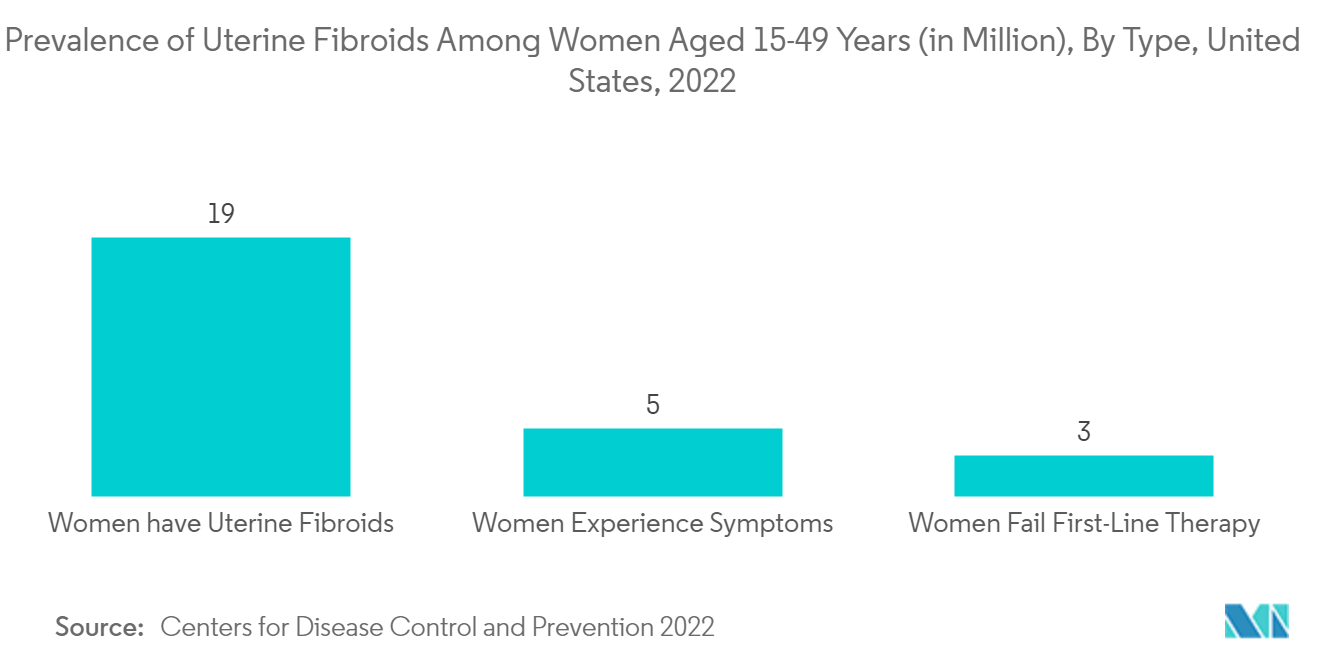Market Trends of Global Uterine Fibroids Treatment Industry
Drugs Segment is Expected to Hold a Share in the Market Over the Forecast Period
The most effective drugs or medications for treating uterine fibroids are gonadotropin-releasing hormone agonists, including leuprolide (Lupron Depot, Eligard, others), goserelin (Zoladex), and triptorelin (Trelstar, Triptodur Kit). GnRH agonists cause a low-estrogen (menopause-like) state, which reduces the size of the tumor and uterus.
Factors such as the rising prevalence of uterine fibroids and increasing demand for effective drugs are forecasted to propel the segment's growth. For instance, according to a study published in September 2022 by the Frontiers Journal, the annual incidence of uterine fibroids is estimated to range between 20% and 77%. Moreover, the prevalence among women under 35 years old is estimated to be between 40% and 60%, while among women over 5d, it is estimated to be between 70% and 80%. This high trend in uterine fibroid cases is anticipated to drive demand for efficacious pharmaceutical interventions, fostering growth within the targeted market segment.
Conversely, the growth of the studied segment is anticipated to be driven by increasing product approvals and developments by key market players. For instance, in June 2022, Theramex received marketing authorization from the European Commission for Yselty (linzagolix), an oral GnRH antagonist designed for treating moderate to severe symptoms of uterine fibroids disease in adult women of reproductive age. Thus, the high burden of uterine fibroids and new product approvals likely increase the usage of these drugs and is expected to boost the segment growth over the forecast period.

North America is Expected to Hold a Significant Share in the Market Over the Forecast Period
North America is expected to hold a notable market share over the forecast period. The presence of well-established healthcare facilities in the region increased government initiatives, and hysterectomy-related surgical procedures/hospital visits are expected to drive the market in North America. Furthermore, the presence of major vital companies and the availability of technologically improved treatment techniques are expected to fuel market growth in this region.
The rising inpatient hospitalizations regarding uterine fibroids prevalence in the United States is expected to drive the demand for effective treatment, thereby boosting the market growth in this region. For instance, according to the article published by Elsevier Inc. in March 2022, in the United States, uterine fibroids emerged as the prevailing pelvic tumors among women in their reproductive years, impacting approximately one-quarter of the adult female population. As per the reference above, fibroids stand as the predominant catalyst behind hysterectomy procedures in the nation, further serving as the principal driver for hospital admissions related to non-pregnancy gynecological conditions. The prevalence of fibroids as the primary cause of hysterectomies and the leading cause of gynecologic hospitalizations drives demand for treatments, thereby propelling the market growth in the region.
On the other hand, the approval of new products, the launch of various advanced treatment options in healthcare facilities for uterine fibroids, and the establishment of different healthcare facilities to address uterine fibroids among women are expected to drive market growth in this region. For instance, in September 2023, Health Canada granted approval for MYFEMBREE for the management of heavy menstrual bleeding linked with uterine fibroids in pre-menopausal women. Thus, the rising prevalence of uterine fibroids, new approvals of various uterine fibroids treatments, and the establishment of different healthcare facilities are expected to boost the market's growth in North America over the forecast period.


